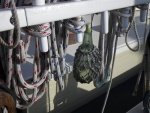Among the many things I do, I am a wilderness medic. In some cases this allows us to perform treatments that are usually only for physicians in hospitals.
At our most recent recert training our instructor heavily espoused povidone iodine solution for wound care and discouraged the use of H2O2. He also advised AGAINST prophylactic antibacterial ointment, especially if it comes in petroleum jelly. The idea being that a wound will heal more slowly with the ointment in there than without, unless there is an infection.
He qualified all of this with situational awareness. Sometimes you are in a place where a real debridement and cleansing of a wound is not possible. In those circumstances he encouraged the antibacterial use at first.
Keep in mind the point of the treatment is often not for the most optimal long-term outcome. A wilderness medic may deliver a course of treatment that will facilitate evac that may not be what would be ideal long-term, but perhaps the risk of staying in the field brings more dire consequences.
Under these circumstances we discuss cauterization of wounds, which is something that can do a lot of good if done properly, but can clearly cause injury if done improperly.
I have successfully stitched a bleeding artery closed in the past, but it was suggested that cauterization of the end of an artery could save someone's life in if a cut like the OP reported occurred and severed an artery.
These reality checks are very good reminders of how quickly things can and do go south out there. You are on your own, and you only have what you bring. Anticipating issues is the best way to efficiently stock your boat, and sometimes, you have to discover your unanticipated issues. Here's hoping everyone can do that in relatively consequence-free environments.
If you aren't sure about things, go get some education. I don't suggest that anyone go through the arduous Wilderness First Responder course if it is not necessary for your work, and/or you have a bunch of extra time and money, but the Advanced Wilderness First Aid offerings from legitimate sources are completely worthwhile. Standard Wilderness First Aid is great too, but it is a very rushed course with too much info packed into too short a time in my opinion.
A WFR Cert will, however get you most of the way to being an EMT as it covers more material than an entry-level EMT course. EMT's generally have a higher requirement for pediatric treatment, so our local FD has a course they provide for WFRs who want to work on ambulances that just provide the missing education in a half day. Most places will work with you like that. It's a great way to approach a career as a medic, as it affords you the opportunity to work in town and out!

